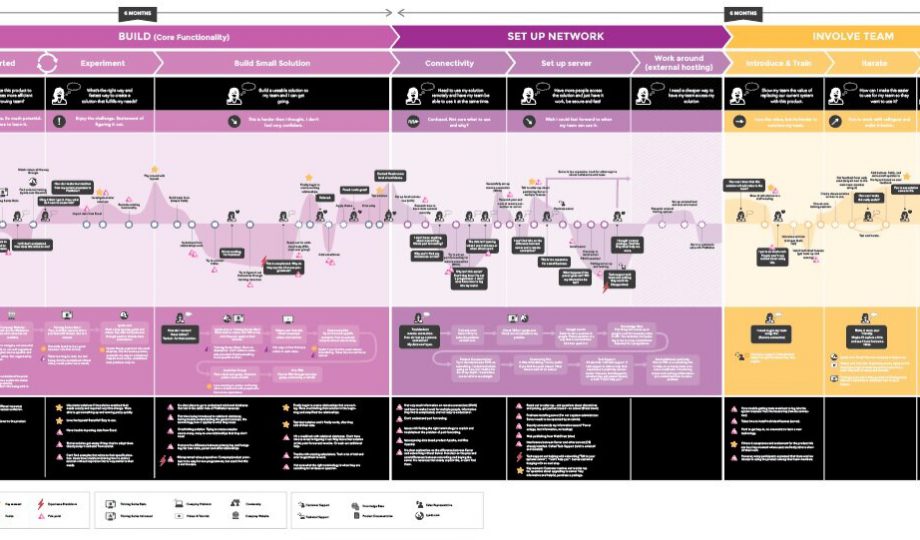When you think about conducting research for UX or service design, you often think of the usual suspects – surveys, interviews, observations, diary studies, workshops, or usability testing. But, there is a less talked about step in the research process that the majority of human-centered design projects involve, which is “desk research”. This might be because it can feel a little academic, or let’s face it, boring, compared to the excitement of talking to real users and hearing firsthand what they have to say about your product or service.
Conducting desk research is a critical step in gaining more context about a problem space, understanding the current landscape, and drawing initial hypotheses for the research you’ll conduct with end-users. It can also be highly valuable for clients and stakeholders to see what trends might be popping up in a particular space (like banking, housing, cyber-security, etc.) and how that might influence business and product decisions down the line.
In this blog, we’ll cover:
- What is desk research?
- When to use desk research in the design process
- The difference between internal and external research
- Six key types of desk research used in UX and service design
What is Desk Research?
Let’s start with the obvious question, what is “desk research”? It’s research you can do at a desk without going into the field. Desk research is a catchall term for different types of secondary research, which means you’re conducting a review of research previously conducted by other researchers. Conversely, primary research (like surveys, interviews, diary studies, and observations) involves gathering data first-hand from users and research participants and generating novel insights. For example, secondary research may involve the literature review of journal articles that describe the findings from interviews and surveys (primary research) completed by another researcher. Desk research is a form of discovery research where you are essentially learning about the topic and problem space before starting to generate ideas and solutions.
When to use desk research in the design process?
Now that you know what desk research is at a high level, when should you conduct desk research? And what the heck is the point of it in the design process?
Desk research is typically done in the preliminary phases of the design and research process, after the project kick-off! This is before you dig into creating a research plan, recruiting users for research, and conducting primary discovery research. We usually conduct desk research as part of project initiation. We might spend two weeks Googling and reading articles and relevant information online, analyzing that information, and thematically drawing conclusions that may then inform interview protocols, research planning, and design work. Sometimes, for quick projects where primary research with users isn’t feasible, desk research can go a long way toward filling in the gaps.
In addition, sometimes for well-researched/well-known problem areas, desk research is all that’s needed. If you’ve already done a ton of user research in the past, or a particular experience has been designed a million times before, you might not need to focus as much on exploratory research with users. Instead, you can do desk research and some usability testing or validation research once the design has started. Beware! We aren’t advocating for not talking to your users – if you’ve never talked to your users or this is a novel space, then you need to conduct desk research AND primary research before you dig into the design phase.
View this post on Instagram
There are several reasons to conduct desk research in the design process, including:
- Informing the direction of primary research (the types of questions you will ask and areas of further exploration.)
- Inspiring your design choices (seeing other design examples of what is being done in the industry you are designing for and analogous industries can give you ideas for what you will design.)
- Developing a business case for conducting research in a new area.
- Better understanding of the context/landscape/problem space.
- Highlighting any trends that may impact the direction of the product/business/service in the near and long term.
Internal vs. External Desk Research
Before we dive into telling you about the different types of desk research out there, we should first talk about where that data is coming from. There are two perspectives to consider in your desk research, 1) what is going on internally with your organization/product/service, and 2) what is going on externally with competitors, other jurisdictions, trends and research in the same or similar spaces. Looking inside your company means doing a review of information and/or research related to your project that has been done already. It’s important to gather this information first, so you have a solid understanding of what’s been done to date, the goals, and also the gaps in understanding. Looking outside your company/organization is important to understand the marketplace, how to position yourselves, and what information can be drawn from other people’s successes and failures. Both are important for information and future research!
The purpose and type of desk research will vary depending on the goals of your project. It’s best practice to use a mix of desk research methods to ensure that the themes you uncover are accurate.
Types of Internal Desk Research
Internal desk research is usually the first place to start because it’s using data that is readily available and accessible, and it will provide you with a better sense of what questions you need to answer through your external desk research (and of course through your primary research with users.)
Here are the three types of internal desk research that we most commonly use in service design and UX projects:
- Document Review (internal) – A document review entails reviewing the existing documentation that your organization may have already created on the same or analogous topic. This is where you and your team will dig into previous research reports, existing user flows, process maps that were previously created, presentations delivered on the topic, and more. This will help you to understand why the project is important to the organization, as well as understand what work has been done previously that may inform the new work, or where new work may actually duplicate effort and be unnecessary.
- As-Is Data Sources (internal) – As-is data sources refer to data that already exists from the internal systems. For example, data and stats that come from the call centre or help desk are often a great place to start. Looking at call volume or the number of tickets created, the types of issues being reported, and the most frequently reported issues, as well as other information that may come from an Interactive Voice Response (IVR) system. Some examples are how quickly tickets are resolved or answers to optional surveys sent out after a support call or ticket was resolved. These are all great examples of places to start with as-is data from internal sources. Note, that this type of desk research doesn’t apply to all projects and is most relevant when dealing with a technology product or service.
- Web-Audit and/or Google Analytics Device (internal) – A web audit is another type of internal desk research method that is relevant to UX design projects. In this exercise, your team would review the existing website or applications, look at overall usability, and make an inventory of site pages and content types, which might inform the future-state information architecture, page layouts, and site structure. A web audit can also include a Heuristic Analysis/Review, which is a whole other method we’ll cover in another blog post! Outside of looking at the content and usability of an existing site or application, it’s also really useful to dig into the Google Analytics of the site. A Google analytics review will look at web traffic statistics and user behaviour data (such as drop-offs, time-on-page, page clicks, and page sequences) to determine common user paths, areas of confusion/frustration, and successful engagement. You can look for content that is searched for most often, which pages and links receive the most traffic, visitor demographics, and more.
These are only three of the internal desk research methods, we haven’t touched on all possible methods, including things like social media audits, which can also be very helpful.
Types of External Desk Research
- Literature review (external) – This might be the desk research method you are most familiar with, and if you went to university, you likely did a fair bit back in the day! A literature review involves reading existing literature (in the form of books, journal articles, reputable online blogs and articles, research reports, white papers, etc.) and highlighting common themes that are appearing across the various secondary sources. Typically, once you highlight a few themes that would be relevant to your project, you’ll report on them by summarizing the theme and providing links to references. A literature review is a helpful pre-discovery exercise, to identify areas of exploration for primary research, inform the research planning, and develop a line of questioning for interviews and surveys. How do you conduct a literature review? Usually, you’ll print off articles, read and highlight important passages, and use coding/tagging methods as repeating ideas appear across the various articles and books.
- Jurisdictional Scan (external) – A jurisdictional scan is very useful when you are conducting research within the government. Oftentimes, in public sector projects, it’s important to understand what other departments and organizations from different countries, provinces, or municipalities are doing in the same space. For example, if you’re completing a digital transformation of motor vehicle registration and bringing those processes online, it might be useful to see how other jurisdictions have successfully done that in the past. A scan will help you identify some experts that you could reach out to from those jurisdictions to ask about their learnings. This is especially important in government because as you can probably guess, public sector work has a lot of red tape and is heavily bureaucratic. Whatever solution you design may require changes to policy, which can impact job functioning and completely change entire departments. So, you need to look into policies that may need to be changed in order to complete the transformation, and in doing that you’d want to learn the successes and failures of others to know exactly what to look out for.
- Competitive Analysis/Comparative Analysis (external) – Evaluate and compare existing products or services in the marketplace. This is particularly helpful in UX/UI projects when you want to understand where your product will fit in the market, how it differs from the competition and any gaps or areas of opportunity that may be untapped. A competitive analysis typically starts with some quick google searches, looking at google images, and also creating a dummy account on your competitor’s sites so you can capture the experience. You might be looking to compare things like ease of use, flow, and features. This work will involve capturing screenshots, screen recording interactions of competitor experiences, and comparing them against several different criteria. Criteria may include, but are not limited to, features, friction, number of clicks, data entry requirements, accessibility compliance, look and feel, and ideal paths/journeys. The value of a competitive analysis is that it can bring the design team a lot of inspiration, it can prove or disprove the value of your product/service, and help your team to find ways to further differentiate your service. Competitive analysis can include things like a simple feature list comparison between the various applications/products in the same space (imaging Asana vs. Trello vs. Monday.com). It may also include documenting detailed user flows in a tool, like Figma or Miro, by grabbing screenshots and linking them together. Another useful analysis is to create a 2×2 framework by which to compare. Choose two meaningful spectrums by which to compare the competitors and hopefully this will show the gaps/areas for growth in the market.
Once again, there are many other methods for conducting external desk research, like looking into trends and strategic forecasting, but we’ll save these for another day! Even though desk research might not be the most “exciting” form of research, it’s important and shouldn’t be left behind. After reading this post, you should better understand what desk research is, exactly how it fits into the design process and the differences between internal and external desk research.





